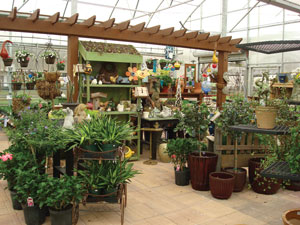11/24/2010
Sunny Days at Sunnyfield
Pam Buddy-D’Ambrosio

When 19 years in a corporate job felt too long for Jeff Johnson, he and his wife, Sheila, turned to the Internet in their search to purchase a greenhouse. Jeff’s management job had taken him away from his horticulture major and it was time to get back.
Jeff and Sheila’s pursuit led them on excursions throughout the Midwest to check out greenhouses, but it wasn’t until they found Ron and Donna Dieter’s Sunnyfield Greenhouse and Garden Center in Galva, Illinois, that they fell in love.
Jeff and Sheila liked the rural atmosphere and the rolling hills that reminded them of their childhood homes in Wisconsin. They liked the modern greenhouse facilities that were updated due to a storm; there was a good customer base; and there was a nice house to live in.
In 2008, Jeff, Sheila, and their children, Whitney and Eric, moved west 130 miles from Plainfield to Galva, in the northwestern part of Illinois. The children were happy to move from the city with nearly 40,000 people to the country with around 3,000 folks, and settle into life at a garden center.
Garden variety
Sunnyfield Greenhouse and Garden Center began in 1978 as a truck farm that sold sweet corn. Once the summer was over, the store closed its doors in September. Since Jeff bought the business, it stays open until October 31. In the future, Jeff and the staff, which includes, Ron and Donna’s daughter, designer Kathryn Newman, have plans to create a haunted greenhouse. Through advertisements, Jeff let the original customers know of the extended hours and the addition of new plants.
Jeff says he has captured a large market with sales of succulents that they grow or buy in as liners. Two years ago they sold two tables of succulents, last year eight tables sold out. Jeff says they promote their extensive collection, which includes echeveria, kalanchoe, agave and aloe, as outdoor container plants during the warm months. Jeff says the customers get warmed up for the planting season and their April 1 greenhouse opening by picking up succulents, which spur additional plant sales.
Jeff grows the same annuals, perennials, veggies and herbs that Ron and Donna grew. Jeff and Kathryn have expanded the list to include 3,000 varieties of plants, and have added 100 to 200 new annual varieties every year. There is 3,000 sq. ft. for veggies, which includes 110 varieties of tomatoes and 55 varieties of peppers. The garden center sells 1,500 hanging baskets per season. If they sell out of particular perennials, they’ll buy the finished plants to replenish the supply. Jeff purchases nursery stock like shade and fruit trees and roses. He says they grow 60% of the plants they sell and bring in the remaining 40%.
Extended offerings
Kathryn grew up at Sunnyfield and lived in the house that Jeff and his family live in now. She went to the University of Illinois, majored in ornamental horticulture, and has put that degree to use over the last ten years by designing the combination plantings in pots, planters, boxes and hanging baskets. She, along with Jeff, instructs customers at the garden center’s workshops, and stresses the importance of teaching customers how to use new plants, how they work in certain conditions and in combination with other plants.
In addition to the workshops, customers come for the homegrown plants and the unique varieties at Sunnyfield, like bulbine that sold out within a week. Some customers drive 90 minutes to get there. “We’re not on a major road, but people find us,” says Jeff. “Good gardeners are on the quest for good greenhouses,” he adds. There isn’t much competition from box stores, and the other greenhouse in the area has 500 sq. ft. compared to Sunnyfield’s 30,000 sq. ft.
From November to March, things slow down. Jeff concentrates on upgrades like the installation of pavers on the walkways and the expansion of the display gardens. The first week of January sees movement in the seeding of the vegetables and pack annuals. In the second week of February the greenhouses are heated and the liners are brought in; planting continues until June. As the season heats up, Jeff and Sheila’s children fill the 4½-in. pots in trays. They call it “doing cups.” Sheila helps with the potting and with the registers from March to May. At peak season, there are twelve employees; two to three work all summer.
Every year, Jeff and the staff take a week to attend the Michigan Garden Plant Tour to see selections and make decisions regarding new varieties for the next season. Jeff gets additional suggestions from trade magazines and from Scott Mozingo, a Ball Horticultural representative.
In the spring, Jeff speaks to garden clubs three nights a week for a total of 40 appearances a year. He brings a Power Point presentation or the actual plants and discusses the new varieties. “They like to see real plants, and nine times out of 10,” he says, “I sell everything.” When asked if he gets many calls asking for advice on the care of plants, Jeff says, “We don’t get a lot of calls; every town has a garden club and they know plants.”
Quick tips
Jeff has these money saving ideas:
- Foster a relationship with community colleges as good sources for horticulture students. Sunnyside hires two or three interns every spring—young, fresh minds who like to work.
- Upgrade the facilities to be more efficient. Switch cold frames to hoop houses for better control.
- Offer the store to master gardeners to give presentations to the customers. It’s an inexpensive way to have assistance.
- Grow your business by going out to people; don’t wait for them to come to you. Speak at garden club meetings.
- Buy on sale! GT
Pam Buddy-D’Ambrosio is a freelance writer in New Rochelle, New York.